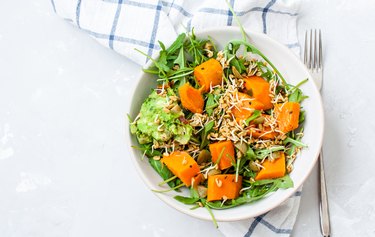
Giving up meat does not relegate you to a diet of salads and celery sticks. You can still enjoy a varied diet with optimal nutrition on a no-meat diet plan. There are benefits of not eating meat — the reduction in calories and saturated fat, compared to a meat-based diet, can help you better manage your weight and health.
Benefits of Not Eating Meat
Video of the Day
A vegetarian diet can provide many benefits of not eating meat and be appropriate for any person at any stage of their life, as long as it is appropriately planned, according to the American Dietetic Association.
Video of the Day
Eating too much red meat, over 18 ounces per week, notes the Harvard School of Public Health, may raise your risk of developing colon cancer. Meat also tends to be higher in saturated fat and calories than many other protein choices. Saturated fat and calories can cause weight gain if you eat too much of them. Vegetarians have a propensity to have a lower body mass index and reduced risk of diseases such as heart disease and cancer.
Types of No-Meat Plans
You could choose to follow a number of paths when following a no-meat diet plan. You might choose to exclude just red meats, such as beef, bison, pork and lamb, or all animal flesh — including poultry and fish. If you choose to exclude fish and poultry along with meat, you may be an ovo-lacto vegetarian who still enjoys dairy and eggs, explains NIH News in Health.
A no-meat plan may also be vegan, meaning you consume no animal products whatsoever and plan your meals around fruits, vegetables, nuts, seeds, grains and plant oils says The American Diabetes Association. All options offer benefits, which one you choose depends on your personal preferences.
Read More: Health Benefits of a Vegetarian Diet
No Meat Challenge
Red meat is a source of iron and vitamin B-12. Vitamin B-12 is essential to energy and red blood cell functioning. Iron also assists in red blood cell function, particularly in helping these cells transport oxygen throughout the body. You can find these nutrients in supplements or naturally occurring in non-meat foods. Nutritional yeast, eggs, fortified cereal and salmon are sources of B-12, while oysters and lentils are alternative sources of iron, suggests National Institute of Health. You might find eating no meat a challenge when it comes to getting sufficient protein but many sources other than meat can provide all the protein you need. If you consume plenty of dried beans, legumes, nuts, seeds and, if you choose, fish, dairy, eggs and poultry, protein deficiency should not be a problem, says Harvard School of Public Health. If you are using a no-meat plan as a diet, make sure you still consume adequate calories for energy. A woman needs at least 1,200 calories per day and a man 1,500 calories.
Read More: 13 Surprising Vegetarian Sources of Protein
Eat Healthy Vegetarian Meals
A 1,500-calorie, no-meat high protein vegetarian meal might begin with a breakfast of two slices of whole-grain toast with 1 tablespoon of almond butter and 8 ounces of skim milk. At lunch, create a dish with 1/2 cup of whole-wheat pasta, 1 cup diced tomatoes, 1 1/2 ounces of mozzarella cheese and 1 cup steamed broccoli. For dinner, enjoy ½ cup of black beans stewed with garlic, onions and a pinch of cumin served over 1 cup cooked quinoa and a salad of baby spinach, 1 cup of orange segments, 1/2 ounce of toasted pecans and a low-fat balsamic dressing. At snack times, have a hard-boiled egg with five woven wheat crackers and, at another sitting, a cup of nonfat, plain Greek yogurt with 1 teaspoon of honey and 1/2 cup of fresh blueberries.
Read More: Pros & Cons of a Vegetarian Diet